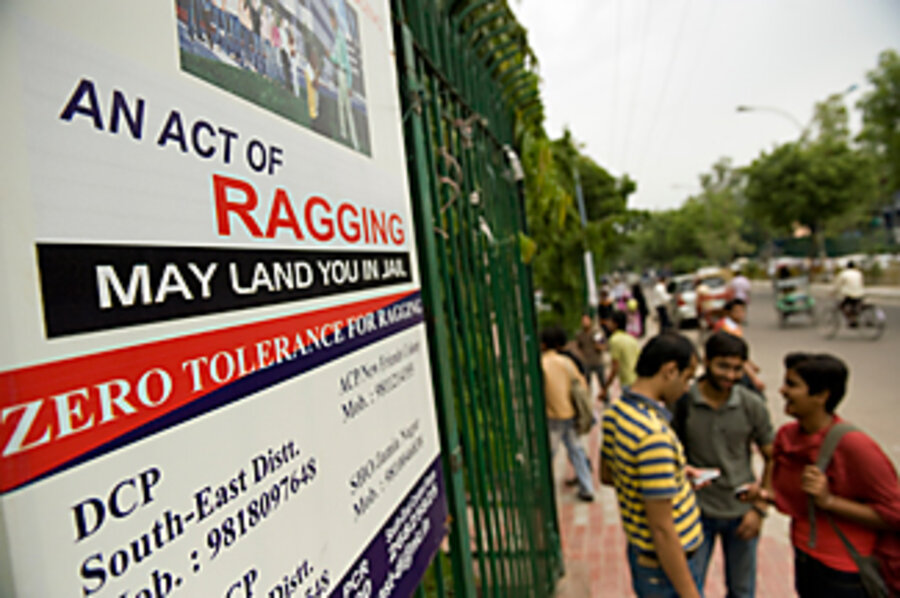In India, Student hazing grows violent
Loading...
| New Delhi
Aman Kachroo was a handsome, easygoing 19-year-old in the first year of medical school in the north Indian state of Uttar Pradesh.
On March 6, at 2 a.m., he was awakened by a group of drunken senior students and dragged out of his bed for a "ragging," the bullying systematically meted out to first-year undergraduates in Indian universities. He and half a dozen other freshmen were slapped, punched, and had their heads beaten against a wall for two hours. The following day, Aman died of brain injuries.
Initiation rites for new students occur throughout the world. But India's version has grown alarmingly violent. Aman's death was the 12th caused by ragging – a tally that includes suicides – in the past year alone, according to the Coalition to Uproot Ragging in Schools (CURE), a nongovernmental organization.
"When I was at university, ragging was a bit of fun," says Aman's father, Raj Kachroo. "So when Aman told me about the ragging a few days before he died, I did not take him seriously.… I now realize it has become something entirely different."
Within days of his son's death, Mr. Kachroo, a former professor of engineering, began a nationwide campaign against the practice. With a team of lawyers, the organization he established, the Aman Movement (www.amanmovement.org), petitioned the Supreme Court to make ragging illegal. In May, the court declared it a "human rights abuse in essence." Now Kachroo, an engineering consultant, has taken a year off to speak in schools and colleges around India to help make that judgment a reality.
With its judgment, the Supreme Court ordered a slew of antiragging measures in every higher educational institution, including stopping funding to universities with especially poor ragging records. The court said universities should have mobile antiragging squads and impose harsh penalties for students who participate in ragging. A national, toll-free help line has also been set up on the court's instruction.
Universities are taking the ruling seriously. At Delhi University, during the month of August, khaki-clad police stood guard at every campus gate. Alongside fliers inviting new students to join extracurricular societies, posters warned that "An Act of Ragging May Land You in Jail."
"I wasn't expecting this," says Arshee Khosla, an economics undergraduate, as she approached police standing outside her campus gate on the first day of the term. She did not find their presence particularly reassuring: "I guess these things happen behind closed doors."
Indeed Kachroo says that while the Supreme Court ruling is a great step forward, it is not, in itself, enough. Without changing peoples' perceptions of ragging and its effects, the law will achieve nothing, he says.
Experts cite several reasons why ragging has become so dangerous.
Harsh Agarwal of CURE believes that Indian undergraduates mimic the kind of hazing rituals they see in Hollywood movies, "but they don't really understand and get it wrong."
Many education experts say that as more low-caste, low-income Indians attend university, ragging is used to subjugate them, although, "just as often it is lower castes trying to hurt upper castes," says Mr. Agarwal. Certainly, Aman came from a successful middle-class family.
Jasmeen Patheja, the founder of Blank Noise, a group that encourages women to actively protest sexual harassment, says that ragging often manifests itself as sexual abuse.
Public displays of sexual harassment, known as "Eve teasing," seem to be on the rise as this deeply conservative society is exposed to the media of more permissive cultures, from explicit films to sexually charged ads.
Last month, in a bid to tackle this growing problem, a college in Uttar Pradesh banned its female students from wearing "vulgar Western" clothing, a category in which it included denim jeans.
For Kachroo, all these changes come down to one thing: "a loss of values. India is becoming materialistic so fast," he says. "Society is becoming selfish and obsessed by power. Ragging is about power."
However complex the causes, he says ragging must be tackled step by simple step – starting with the heads of colleges and universities. "These guys are in their 50s and 60s, and they don't understand how ragging has changed," he says.
He has a big task ahead: India has at least 20,000 colleges of higher education and more than 20 million students. So he is starting by approaching the governors of each of the country's 28 states. State governors here are automatically appointed chancellor of the states' universities.
"Some are very helpful, and they get straight on the phone to arrange meetings," he says. "Others say, 'I will write a letter,' and you know then that nothing is going to happen."
If he doesn't reach enough colleges this year, Kachroo adds, he will take another year off work, funds allowing, to continue his campaign. "If I don't do it, no one else is going to," he says.





